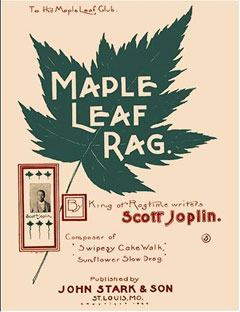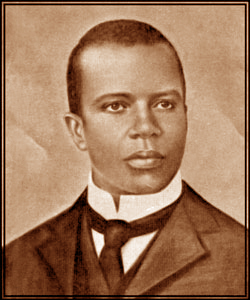

Ragtime is one of the precursors of jazz (it later merged with jazz). This style of popular music emerged around the turn of the twentieth century, and it describes music with a ragged or syncopated rhythm. Syncopation is a term that means the music has an irregular feel to the rhythm, and this is generally achieved when the musical accent is shifted from a strong beat to a weak one, producing rhythmic patterns with unexpected accents. [138]
It is significant to mention that the syncopated rhythms of ragtime and many elements of blues and jazz are based on the folk music and rhythms of black Americans, many of whom were forcibly brought to America as slaves. Some of the forms of music contributing to blues and jazz included the improvised work songs of slaves called field hollers, and call and response songs. Field hollers were a plaintive, spontaneous solo by a worker. Call and response songs involved a leader calling out a line of text (using a musical form of rhythmic speech), which was then answered by the other workers in unison. The text of these work songs often centered around personal misfortune or how hard the work was; basically, complaints about the challenges of life and how the singer felt "blue." The concept of call and response was later used in jazz for instrumentalists to alternate musical exchanges back and forth.

Other music contributing to blues and jazz included the music sung by black religious congregations: gospel hymns, also called spirituals for "spiritual hymns." Spirituals frequently used the call and response technique and syncopated rhythms. Another form of music contributing to early forms of jazz took place in the mid-1800s, when plantation slaves would imitate the ballroom promenades of their masters in a dance called the cakewalk (it was more of a march than a dance). Dressed in fancy clothes, the slaves would use strutting, high and exaggerated steps and kicks, and were accompanied by a march with syncopated rhythms. The best stepping couple would often win a cake, thus this form of dance was called cakewalk. The ragged, syncopated rhythms used in these plantation cakewalk dances eventually became known as ragtime music. [139] [140]
One of the most prominent early composers of ragtime music, was Scott Joplin (1868-1917). Joplin was the son of a violin playing former slave (his mother was not a slave), and he was one of the first black Americans to become a prominent composer. Some of Joplin’s most popular compositions were his piano rags. Rag means a piece composed in the style of ragtime. Joplin is often called the "King of Ragtime Writers," and his Maple Leaf Rag sold half a million copies by 1909. [141]
© Copyright 2025 RK Deverich. All rights reserved.
Although this online cello class is provided free of charge, all rights are reserved and this content is protected by international copyright law. It is illegal to copy, post or publish this content in any form, and displaying any of this material on other websites, blogs or feeds is prohibited. Permission is given for individual users to print pages and perform music from this website for their personal, noncommercial use.